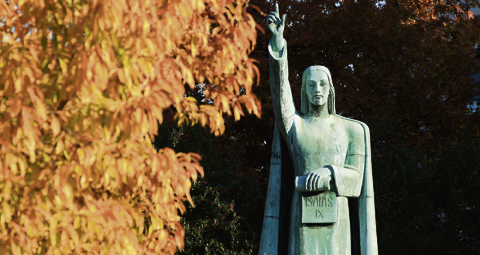February 20 | ![]() 0 COMMENTS
0 COMMENTS ![]() print
print

Saving the world was in Christ’s nature
By Fr Ronald Rolhesier
Numerous groups and individuals today are challenging us in regards to our relationship to mother-earth. From Green Peace, from various environmental groups, from various Christian and other religious groups, and from various individual voices, comes the challenge to be less-blind, less-unthinking, and less-reckless in terms of how we relate to the earth.
Every day our newscasts point out how—without much in the way of serious reflection—we are polluting the planet, strip-mining its resources, creating mega-landfills, pouring carbon dangerously into the atmosphere, causing the disappearance of thousands of species, creating bad air and bad water, and thinning the ozone layer. And so the cry goes out: live more simply, use fewer resources, lessen your carbon footprint, and try to recycle whatever you’ve used as much as you can.
That challenge, of course, is very good and very important. The air we breathe out is the air we will eventually inhale and so we need to be very careful about what we exhale. This planet is our home and we need to ensure that, long-term, it can provide us with the sustenance and comfort of a home.
However, true as this is, there’s still another, very important reason, why we need to treat mother-earth with more caution and respect, namely, Christ, Himself, is vitally bound-up with nature and his reasons for coming to earth also include the intention of redeeming the physical universe. What’s implied here?
Let me begin with an anecdote which captures, in essence, what’s at stake. The scientist-theologian, Pierre Teilhard de Chardin, in conversation with a Vatican official who was confused by his writings and doctrinally-suspicious of them, was once asked: “What are you trying to do in your writings?” Teilhard’s response: “I am trying to write a Christology that is wide enough to incorporate the full Christ because Christ is not just an anthropological event but he is also a cosmic phenomenon.” Simply translated, he is saying that Christ didn’t just come to save people, he came for that yes, but he also came to save the planet, of which people are only one part.
In saying that, Teilhard has solid scriptural backing. Looking at the scriptures we find that they affirm that Christ didn’t just come to save people, He came to save the world. For example, the Epistle to the Colossians (1, 15-20) records an ancient Christian hymn, which affirms both that Christ was already a vital force inside the original creation—‘that all things were made through Him’—and that Christ is also the end point of all history, human and cosmic. The Epistle to the Ephesians, also recording an ancient Christian hymn, (1, 3-10) makes the same point; while the Epistle to the Romans (8,19-22) is even more explicit in affirming that physical creation, mother-earth and our physical universe, are ‘groaning’ as they too wait for redemption by Christ. Among other things, these texts affirm that the physical world is part of God’s plan for eventual Heavenly life.
What’s contained in that, if we tease out its implications? A number of clear principles. First, nature, not just humanity, is being redeemed by Christ. The world is not just a stage upon which human history plays out; it has intrinsic meaning and value beyond what it means for us as humans. Physical nature is, in effect, brother and sister with us in the journey towards the divinely-intended end of history. Christ also came to redeem the earth, not just those of us who are living on it. Physical creation too will enter in the final synthesis of history, that is, Heaven.
Second, this means that nature has intrinsic rights, not just the rights we find convenient to accord it. What this means is that defacing or abusing nature is not just a legal and environmental issue, it’s a moral issue. We are violating someone’s (something’s) intrinsic rights. Thus when we, mindlessly, throw a coke-can into a ditch we are not just breaking a law we are also, at some deep level, defacing Christ. We need to respect nature, not, first of all, so that it doesn’t recoil on us and give us back our own asphyxiating pollution, but because it, akin to humanity, has its own rights. A teaching too rarely affirmed.
Finally, not least, what is implied in understanding the cosmic dimension of Christ and what that means in terms of our relationship to mother-earth and the universe is the non-negotiable fact that the quest for community and consummation within God’s Kingdom—our journey towards Heaven—is a quest that calls us not just to a proper relationship with God and with each other, but also to a proper relationship with physical creation.
We are humans with bodies living on the earth, not disembodied angels living in Heaven, and Christ came to save our bodies along with our souls; and He came, as well, to save the physical ground upon which we walk since He was the very pattern upon which and through
— Fr Ronald Rolheiser is a Catholic priest and member of the Missionary Oblates of Mary Immaculate. He is president of the Oblate School of Theology in San Antonio, Texas. Visit his website at www.ronrolheiser.com










